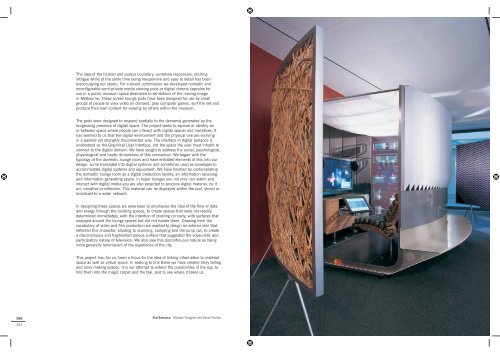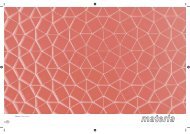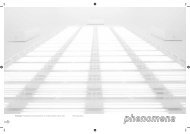Media - ross mcleod
Media - ross mcleod
Media - ross mcleod
You also want an ePaper? Increase the reach of your titles
YUMPU automatically turns print PDFs into web optimized ePapers that Google loves.
106<br />
107<br />
The idea of the blurred and porous boundary, somehow responsive, eliciting<br />
intrigue while at the same time being inexpensive and easy to detail has been<br />
preoccupying our studio. For a recent commission we developed nomadic and<br />
reconfigurable semi-private media viewing pods or digital cinema capsules for<br />
use in a public museum space dedicated to exhibitions of the moving image<br />
in Melbourne. These screen lounge pods have been designed for use by small<br />
groups of people to view video on demand, play computer games, surf the net and<br />
produce their own content for viewing by others within the museum.<br />
The pods were designed to respond spatially to the demands generated by the<br />
burgeoning presence of digital space. The project seeks to explore or identify an<br />
in-between space where people can interact with digital spaces and narratives. It<br />
has seemed to us that the digital environment and the physical one are evolving<br />
in a parallel yet strangely disconnected way. The interface in digital parlance is<br />
understood as the Graphical User Interface, not the space the user must inhabit to<br />
connect to the digital domain. We have sought to address the social, psychological,<br />
physiological and haptic dimensions of this connection. We began with the<br />
typology of the domestic lounge room and have enfolded elements of this into our<br />
design, some translated into digital systems and sometimes used as envelopes to<br />
accommodate digital systems and equipment. We have finished by contemplating<br />
the domestic lounge room as a digital production facility, an information receiving<br />
and information generating space. In hyper lounges you not only can watch and<br />
interact with digital media you are also expected to produce digital material, be it<br />
art, narrative or reflection. This material can be displayed within the pod, stored or<br />
broadcast to a wider network.<br />
In designing these spaces we were keen to emphasise the idea of the flow of data<br />
and energy through the building spaces, to create spaces that were not readily<br />
determined immediately, with the intention of creating curiosity, with surfaces that<br />
wrapped around the lounge spaces but did not isolate them. Drawing from the<br />
vocabulary of video and film production we wanted to design an exterior skin that<br />
reflected this character, alluding to scanning, sampling and the jump cut, to create<br />
a discontinuous and fragmented porous surface that suggested the voyeuristic and<br />
participatory nature of television. We also saw this discontinuous nature as being<br />
more generally reminiscent of the experience of the city.<br />
This project has, for us, been a focus for the idea of linking information to material<br />
space as well as virtual space. In seeking to link these we have created story telling<br />
and story making spaces. It is our attempt to extend the possibilities of the rug, to<br />
fold them into the magic carpet and the taxi, and to see where it takes us.<br />
Pod Entrance Michael Trudgeon and David Poulton




